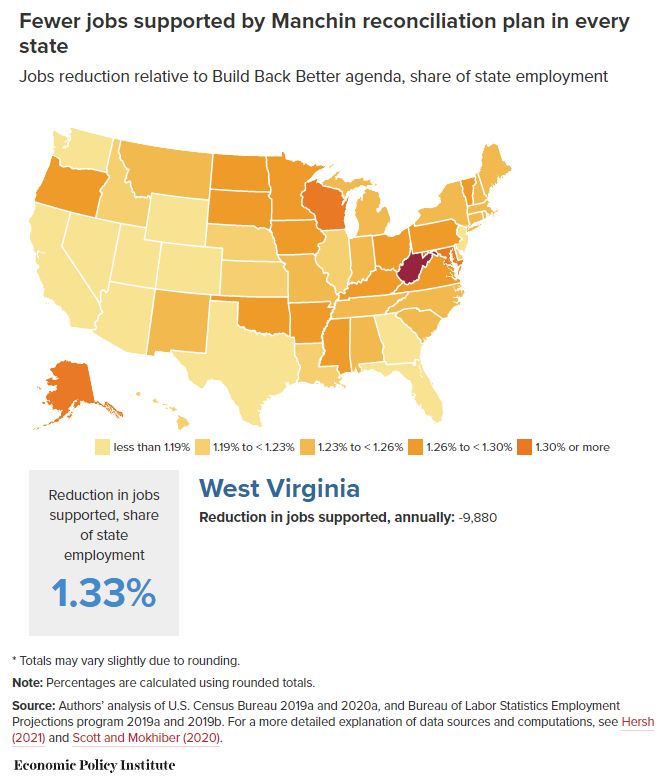Economic recovery from the COVID-19 pandemic has slowed in recent months, as a wave of new delta variant cases has left its mark on the job market. After adding an average of 889,000 jobs per month in May, June, and July, the nation added only 366,000 in August and only 194,000 in September, leaving the economy still 4.97 million jobs short of its pre-pandemic levels. West Virginia experienced a similar trend. After adding an average of 2,600 jobs per month in 2021 through July, the state lost 200 jobs in August, and is still down 28,700 jobs from its pre-pandemic level.
With the recovery slowing, it is more important than ever to make the robust investments included in the Build Back Better agenda that will both support millions of jobs and address many longstanding needs that have been highlighted and exacerbated by the pandemic. However, Congress is considering cutting back the scale and scope of the the package, with West Virginia’s Senator Joe Manchin calling for the reconciliation package to be cut from $3.5 trillion to $1.5 trillion over 10 years. This would mean the legislation would support far fewer jobs and deliver far fewer benefits to lift up working families and boost the economy as a whole.
The Build Back Better agenda, combining the Bipartisan Infrastructure Framework and the proposed $3.5 trillion budget reconciliation package, is estimated to support more than 4 million jobs annually, including over 17,000 annually in West Virginia.
According to an analysis by the Economic Policy Institute, slashing the budget reconciliation package from $3.5 trillion to $1.5 million, as proposed by Senator Manchin, would mean nearly 2 million fewer jobs supported per year nationwide. In West Virginia, the number of jobs supported per year would fall from 17,290 to just 7,490, a reduction of 9,880 jobs per year.

The reduction in jobs supported is equivalent to 1.33 percent of the state’s overall employment. The health care and social assistance sector would be most impacted, with West Virginia seeing 3,800 fewer of these jobs. The state would also see 900 fewer manufacturing jobs and 400 fewer construction jobs, while being no better off in terms of fossil fuel industry jobs.
Scaling back the Build Back Better agenda would not only mean delivering fewer tangible benefits to West Virginia families, it would also severely compromise the recovery plan’s value as macroeconomic insurance against the recovery waning in the coming years. The provisions of the American Rescue Plan, including stimulus payments, enhanced unemployment benefits, increased Medicaid match rates, and billions in state and local government aid, have helped fuel the recovery and have kept West Virginia’s economy afloat throughout the pandemic. However, the impact of these provisions will soon fade, even though the state and national economy are far from fully recovered. In past recessions, withdrawing fiscal support prematurely resulted in protracted recoveries and prolonged spells of high unemployment. The Build Back Better agenda is designed to prevent that from happening and is intended to get the economy back to full capacity, without causing high inflation or adding to the federal debt.
The Build Back Better agenda would make historic investments in some of West Virginia’s most longstanding needs, such as lack of child care, food insecurity, and lack of good pay for critical jobs like our child care and home health workforces, while also addressing rising income inequality. These investments would strengthen the nation’s and the state’s long-term economic growth, support millions of jobs, and deliver real benefits to workers and families. Scaling back would be moving in the wrong direction.